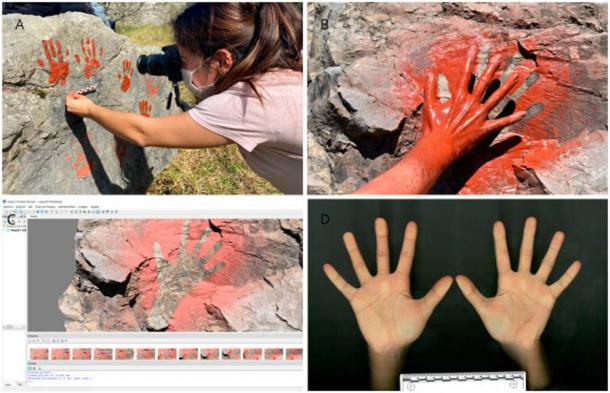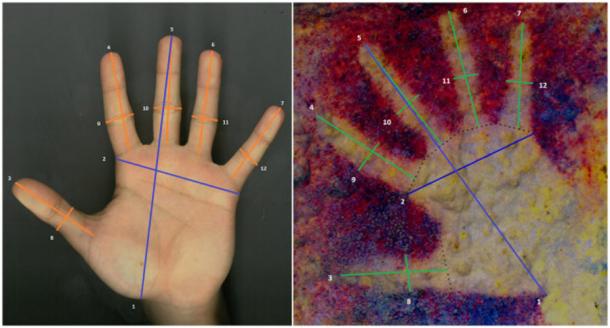
A Whopping 25% of Prehistoric Rock Art Could Be Children’s Art, Study
Child artists are not just a modern reality. They have left their artistic fingerprints on countless ancient surfaces. Now, a new study published in The Journal of Archaeological Sciences points to how much of prehistoric rock art corpus is actually children’s art. The study analysis included 750 Paleolithic hand stencils from all over Western Europe, including Spain, Italy, UK, and France, which revealed that close to a quarter of these paintings were children’s art, produced by infants, children, and juveniles!
Diego Garate, of the Cantabria International Institute of Prehistoric Research, and one of the co-authors of the study, said that “Our main aim is to gain a much deeper knowledge, not of the art itself that these societies produced, but of the protagonists, the men and women who created these artworks during the Paleolithic period.”

A recent study analyzed 750 works of prehistoric art, including cave paintings, hand stencils and more to conclude that roughly 25% of all the works were children’s art! (The Journal of Archaeological Sciences)
Study Analysis Reveals Primitive Children’s Art Was Common!
That children’s art makes up 25% of the prehistoric art corpus radically alters our perception of rock art, because it had long been assumed to be a solitary male practice and pursuit, instead of a family-oriented group activity. However, this study by experts from UK’s Cambridge University and Spain's University of Cantabria provides solid evidence for the assertion that 20-25% of Western European cave art was made by children between the ages of 2 and 12.
Verónica Fernández-Navarro, lead author of the study, said, “It would appear that artistic activity was not a closed activity closely linked to male individuals and the survival of the group, as had been thought until now.”
- Ten Mysterious Examples of Rock Art from the Ancient World
- Archaeologists Identify First Prehistoric Figurative Cave Art in Balkans - It’s Symbolic!
A total of 180 cave paintings found in the Spanish caves of El Castillo, Maltravieso, Fuente de Salín, Fuente del Trucho, and La Gama, dated to 20,000 years ago, were analyzed with 3-D models of hand paintings by the Handpas Project, in the Cantabria, Aragon and Extremadura region. After this step, each work of art was subjected to advanced biometric analysis to gauge and ascertain the age of the individuals who “worked on” that particular artwork. These results were subsequently juxtaposed with modern population samples.
“From the real hand to the one on the wall there are always a few centimetres of error, because the silhouette comes out larger. We calculated that error and many more children's hands came out than we expected,” said Dr. Fernández-Navarro.
What suggested an element of group cohesion was that toddlers, babies, infants, whose handprints were witnessed, did not have sufficient strength to blow the pigment hard enough to make the art themselves. Therefore, parents or other group members would assist them in the process, creating an activity with “group cohesion.”

The recent study on the amount of children’s art in the total corpus of known prehistoric art took particular care to separate juvenile hands and marks from adult ones, but this isn’t 100% accurate for numerous reasons. ! (The Journal of Archaeological Sciences)
Linking Prehistoric Handprints To Age Is Still Challenging!
Obviously it is not easy to separate a child’s hand or mark from a hand or mark made by a small adult, for example. Since these prehistoric images were made by blowing pigments through hollow reeds, or bones, and then the hands were placed against the wall, the outlines of the image that formed could be slightly larger than the hands themselves, reports Artnet News. The researchers, however, claim to have accounted for this error through plain observation: 25% of the hand marks were not large enough to belong to adults or teenagers.
The second accuracy issue is one that the authors of the study write about, namely, what constitutes an adult? This question assumes particular significance when we take into the result of centuries of social conditioning and construction. “It is a conception influenced by different factors: on one hand, biological and osteological development and, on the other, the social construction of the idea, which reflects the beliefs and needs of a society at a given moment,” write the authors in the study.
The authors add that any and all terminologies used in definitions, in general, vary according to the author and time period, and depend on the factors used in generating the classification, making them dynamic in nature.
- Tibetan Hand and Footprints May Be Oldest Prehistoric Art
- Native American Art: Thousands of Artists But Only a Fraction of Their Masterpieces Have Survived
“In some caves patterns have been found, some of the hands have missing or bent fingers, and the positions repeat in a specific way. We want to find out if it is a code that they knew how to interpret, in the same way that we today interpret a ‘stop’ sign,” says Dr. Fernández-Navarro.
Moving forward, this change in methodology and viewership points to the possibility of reinterpreting our established understanding of the earliest rock art, and the role of children’s art in larger prehistoric community activities.
Top image: Handprints are the key element of the children’s art contribution in prehistoric times revealed in this study. Source: Nattapol_Sritongcom/Adobe Stock
By Sahir Pandey
References
Badcock, J. 2022. Prehistoric rock art was often the handiwork of children and babies. Available at: https://www.telegraph.co.uk/world-news/2022/03/11/ancient-handprints-reveal-children-babies-created-quarter-prehistoric/
Cascone, S. 2022. A Study of Prehistoric Painting Has Come to a Startling Conclusion: Many Ancient Artists Were Tiny Children. Available at: https://news.artnet.com/art-world/children-worlds-first-artists-new-study-finds-quarter-prehistoric-spanish-hand-paintings-kids-13-2084734
Fernández-Navarro, V., Camaros, E., Garate, D. 2022. Visualizing childhood in Upper Palaeolithic societies: Experimental and archaeological approach to artists’ age estimation through cave art hand stencils. Journal of Archaeological Science, 140. Available at: https://doi.org/10.1016/j.jas.2022.105574
Tonkin, S. 2022. Prehistoric finger painting! Children and babies could be responsible for up to a QUARTER of ancient rock art across Spain, hand analysis reveals. Available at: https://www.dailymail.co.uk/sciencetech/article-10610313/Children-responsible-QUARTER-ancient-rock-art-Spain.html
















Comments
You can make it a given that the children of any human culture, current or ancient, will produce some ‘works’ of art. It’s human nature. Where does this NOT happen? So, in evaluating the human-made objects that are found in all sites where they are looking/digging, a question MUST be, ‘was a child or an adult responsible for this?’
Nobody gets paid to tell the truth.
Of all the stupid analogies.. give kids paint or mud or even feces, and you’ll find hand prints and squiggly lines. OK but to call it art, definately BS. it’s like calling fossilized footprints “line dance”
These so called researchers are so stuck in trying to get a paper published, they forget reality and make assumptions that are just plain embarrassing to the reader. too bad they can’t see these same kids doing shadow puppets by the campfire or they’d insist they’d found the birth of stage drama.